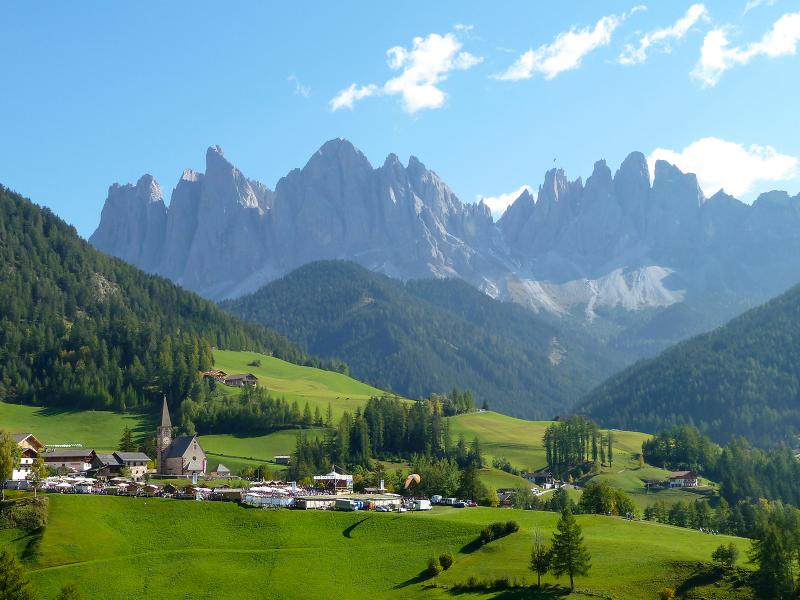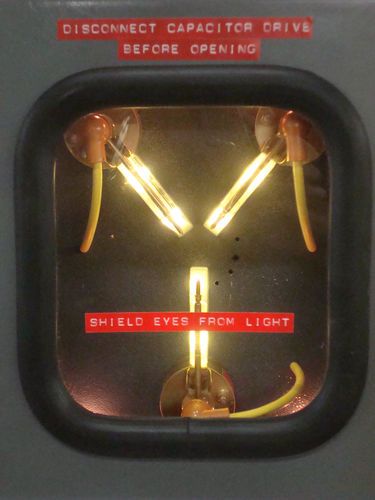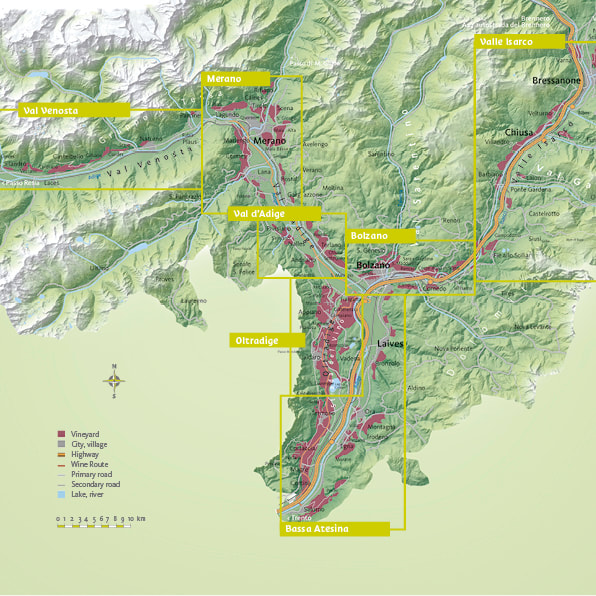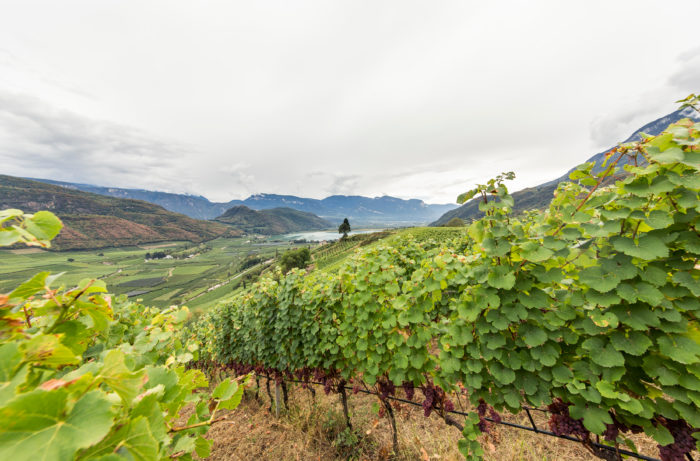n
My go-to place for delicious every-day wines? More often than not, it’s Alto Adige. For those who are unfamiliar, the region of Alto Adige lies to the far north in Italy. It’s an alpine region bordered on one side by the Swiss and Austrian Alps and the Dolomites on another. As a place, it’s about as far removed from the stereotypical Tuscan countryside of misty hills lined with Cyprus trees as possible.
Historically, Alto Adige was part of the Austro-Hungarian Empire until the end of WWI. Bolzano, its major city of some 100,000-plus, is a leisurely 90-minute drive from Innsbruck, Austria, site of the 1976 winter Olympics. No surprise that over 70% of the people in the region speak German–and infrequently Italian. Several times I’ve overheard winemakers in conversation talking about how they send their kids to school in Italy or were about to head south to vacation in Italy. I would remind them that they lived in Italy only to be met with a shrug and the briefest hint of a smile. Regionality, as elsewhere in Italy, runs deep.
For wine, Alto Adige is one of the Italy’s smallest regions with approximately 5,000 growers farming just over 13,300 acres. Mind you, Napa Valley has approximately 45,000 acres under vine, while the Chianti DOCG has over 41,000 acres planted. But quality here is king with over 98% of the wines produced designated as DOC-level. No other region in Italy is close in overall wine quality.
The region’s unique climate is the result of a number of factors. The Dolomites and the Swiss–Austrian Alps act as an enormous rain shadow that protect the area from temperature extremes during the winter. Mediterranean influence from the south makes for some of the warmest temperatures in Italy during the summer. Combined, they create a wide diurnal shift with a marked separation between high daytime and low night temps. For viticulture that means the fruit (both apples and grapes) achieves desired ripeness levels and yet retains high natural acidity, creating balance, purity of fruit, and potential longevity in the wines.
The Alto Adige region is a patchwork of valleys and mountains with vineyards planted between 600 and 3,300 feet. The soils range from calcareous and limestone near the ever-present Dolomites to volcanic porphyry and moraines, the remains of glaciers that retreated from the region some five-to-six million years ago. The sum total is home for over 20 grape varieties with the soil determining the variety planted; whites on the chalk and limestone closest to the Dolomites and red grapes thriving in the Moraines and porphyry-based soils.
Think Back to the Future movies and the Y-shaped circuit that enabled the stainless steel DeLorean to journey through time. The comparison works. Alto Adige’s three major valleys form a letter “Y” with Bolzano as its hub (backtothefuture.wikia.com/wiki/Flux_capacitor).
To the northeast is Valle d’Issarco, just minutes away from the Austrian border. Chiusa and Bressanone are the most important towns and the historical abbey, Abbazia di Novicella, is one of the leading cooperative producers. The abbey dates from the 12th century and the Santa Maria Assunta is one of the most beautiful small basilicas I’ve ever seen. Soils here are mainly granitic and white grapes predominate plantings with some excellent Schiava produced as well.
The Val Venosta lies to the northwest of Bolzano with Merano as the major city. It’s the driest region in Alto Adige and also one of the centers for apple production. It’s also the most scarcely planted valley of the three with poryphry and volcanic soils. White grapes dominate plantings. Additionally, the region is known for its mild climate, and has long been regarded as an excellent spa resort town.
The Oltradige Valley in the south is the largest of the three valleys and the heart of Alto Adige wine production. Appiano and Caldaro are the most important villages. Limestone and porphyry soils are found as well as moraines. White wines account for 56% of the production with vineyards planted between 1,000 and 2,300 feet. The village of Tramin, spiritual home to the Gewürztraminer grape, is also located here.
At the center of the flux capacitor is the city of Bolzano, one of the warmest parts of the entire region. The vineyards of the Santa Maddalena DOC rise steeply just to the northwest of the city. The soils are poryphry-based and perfectly suited to Schiava-based reds as well as Lagrein.
Cooperatives: A Reality Check
Over 70% of the wine in Alto Adige is co-op-produced. That’s because the region’s vineyards are minuscule in size on average and severely fragmented in terms of ownership–just like Burgundy. Thus, commercial winemaking on any scale can only exist within the framework of cooperatives. Usually, cooperatives are factories cranking out oceans of mediocre plonk. Not true in Alto Adige. Normally a cooperative is independently owned and buys grapes on contract from local growers. However, coops in Alto Adige are owned by the growers and everyone working at the coop is an employee. Growers therefore have a huge vested interest in farming the best possible fruit and setting high standards in winemaking. No surprise that the average quality of the wines is very high, and in some case outstanding. Terlano is a perfect example of one of the several Alto Adige coops making exceptional wine.
Grapes Varieties
Alto Adige is a small region with a surprising number and range of grape varieties. Here’s a quick survey of the major varieties from the region.
Whites Grapes
Pinot Bianco: is grown throughout the region. Pinot Bianco isn’t usually a grape that gets everyone dangerously excited but I was surprised, no make that shocked, at how well it can age give the right conditions. To point, Klaus Gasser of Terlano opened bottles of the winery’s Pinot Bianco from 1982 and 1955. The ’55 was deep golden in hue and still very fresh and alive. Otherwise, Alto Adige Pinot Bianco gets my vote for best every-day white wine. It belongs on every wine list much less every wine-by-the-glass list.
Pinot Grigio: there’s an ocean of Pinot Grigio made throughout northern Italy, most of it unremarkable. The best wines from the variety are definitely from Alto Adige and combine bright green pear/pear skin and juicy citrus fruit with wet stone minerality.
Gewürztraminer: gets its name from the village of Tramin in the Oltradige Valley. In terms of style, the Alto Adige Gewürztraminer has all the flamboyant floral-spice fruit qualities one expects from the grape while keeping elegance in style and purity of fruit.
Riesling: the few Rieslings I tasted during the week reminded me of scaled-down versions of dry Austrian wines with tart citrus fruit and stony mineral qualities.
Grüner Veltliner: one comes across Grüner in the north near the Austrian border. Here the style resembles the lighter versions from the Austrian Kamptal region versus the richer Federspiel and Smaragd wines of the Wachau. Still, there’s plenty of the peppery and slight vegetal notes that make Grüner so delicious.
Kerner: another grape that usually goes under the radar and for
good reason—it’s not exactly riveting. But I did find several wines, most notably the Praepositus from Abbazia di Novacella, to be delicious with ripe Fuji apple and quince notes and a wonderful floral quality.
Sylvaner: there are several producers making outstanding Sylvaner in Alto Adige with all the smoky succulent apple/pear and sweet citrus fruits and tart acidity one could hope for.
Sauvignon Blanc: the best Alto Adige Sauvignons show vibrant citrus and tropical fruit with bright pyrazinic-bell pepper notes and mineral.
Moscato Giallo: thought to have been brought to the region by the ancient Romans. Succulent, fully dessert sweet, and dry versions are made.
White Blends: one of the great secrets of Alto Adige. In the Terlano region blends based on Chardonnay, Pinot Bianco, and Sauvignon Blanc are a long-held tradition. I think they’re utterly delicious. In particular, Manincor’s Réserve della Contessa and Terlano’s Nova Domus Riserva are outstanding.
Schiava: I’m a huge fan of Schiava. It’s a wonderful combination of Pinot Noir-elegance and tart Barbera acidity with unique savory qualities. Light in color, deceptively concentrated, and Beaujolais-like, it can be served chilled and goes with anything and everything. You might see it also labeled as Vernatsch or Edel Vernatsch (remember the German influence). The best Schiava-based wines are from the Santa Maddalena DOC where they are blended with a maximum 10% Lagrein. Try one—delicious!
Lagrein: other than ease of pronunciation (it rhymes with wine), Lagrein could also be the next geek wine. Malbec-purple in color with Merlot-soft tannins and a tart, savory, floral character all its own. Another must-try.
Pinot Noir: Alto Adige Pinots remind me of Spätburgunder from Germany with tart cranberry/rhubarb fruit, beet, tea/herb and earth notes. Elegance and finesse are common hallmarks.
Merlot: primarily grown in the warmer south closer to Trento. Bottled both as a single varietal and blended with Cabernet Sauvignon. The best examples have lush black fruits, herbal notes and minerality.
Cabernet Sauvignon: ditto above with the best examples showing vibrant blackcurrant and herb notes with clay earth.
Moscato Rosa: my new favorite sticky. Moscato Rosas are luscious, just-right sweet and spicy. Chocolate wine!
Random Thoughts
Apples! Alto Adige is the center of apple production in Italy and one of the major suppliers to the European continent. The valley floors are filled with apple orchards with vines on hillsides and terraces. However, a high bounty is also placed on top orchards grown on steep hillsides.
Foods: when in Bolzano, makes sure to try the local dumplings called knödels, made from cheese, beets, speck (local ham like prosciutto) or spinach. Knödels are usually served with melted butter. Need I say more? The crunchy unleavened bread called schüttelbrot is also delicious.
Take Aways
Overall, I think of Alto Adige wines as having wonderful balance, purity of fruit, and diverse mineral-earth qualities. In the restaurant they show great value and versatility with a wide range of cuisines—not to mention fantastic quality-price value. At home they excel in the delicious factor. Needless to say, I’m a huge fan.
Wines to Look For
Here is a list of wines I’ve tasted recently. All are highly recommended. They’re also distributed nationally, so look for them in your local market. One more note: it’s Thanksgiving week. Alto Adige wines hit the sweet spot for pairing with the traditional turkey day meal. Seek them out–you’ll be glad you did.
Pinot Bianco
2016 Muri Gries Pinot Bianco “Abtei Muri”
2017 Alois Lageder Pinot Bianco “Haberle”
2016 Cantina Terlano Pinot Bianco Riserva “Vorberg”
Pinot Grigio
2018 Cantina Valle Isarco Pinot Grigio “Aristos”
2017 Cantina Kurtasch Pinot Grigio “Penóner”
2017 Colterenzio Pinot Grigio
Sauvignon Blanc
2016 Cantina Kurtatsch Sauvignon “Kofl”
2016 Cantina Terlano Sauvignon “Quartz”
Kerner
2018 Abbazia di Novacella Kerner
Gewürztraminer
2018 Elena Walch Gewürztraminer “Vigna Kastelaz”
2017 Cantina Tramin Gewürztraminer “Nussbaumer”
White Blends
2017 Elena Walsch Bianco DOC “Beyond the Clouds”
2016 Manincor Réserve della Contessa
Schiava
2018 Castel Sallegg Lago di Caldaro “Bischofsleiten”
2017 Cantina Kaltern Lago di Caldaro Classico “Quintessenz”
Pinot Nero
2016 Alois Lageder Pinot Nero “Krafuss”
2016 Castelfeder Pinot Nero “Burgum Novum”
Lagrein
2018 Cantina Bozano Lagrein “Perl”
2017 Tiefenbrunner Lagrein “Turmhof”
2016 Cantina Terlano Lagrein Riserva “Porphyr”
nn



